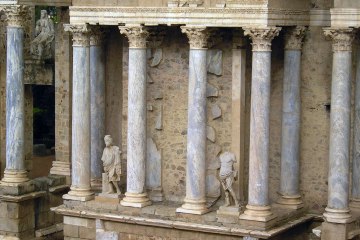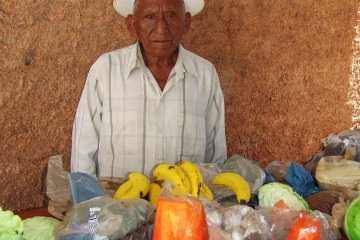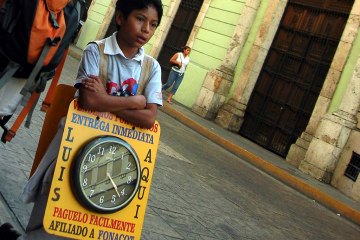Not only has Mérida been the capital of the State of Yucatan since colonial times, it was also an important center for the ancient Mayan culture as well. It is filled with lovely Old Spanish colonial architecture, much of which is in various states of restoration. As it has been throughout its history, Mérida today is a commercial, artistic and medical center for the region.
Before we get into all the good things about Mérida, a couple negatives – This is one of, if not the hottest city in Mexico. If you can time it, you will enjoy a visit there in winter a great deal more than in summer. With that said, we did visit once in August and while in a constant state of perspiration, still enjoyed our stay. The other point is also weather related. There are no storm drains in Mérida. If it rains, you can pretty much assume that the streets will flood.
One of the things we enjoy about Mérida is the free street entertainment that’s available most nights of the week. On Mondays, there is traditional music and dancing on the main plaza in the center of town. On Tuesdays, you can catch big band music at Santiago Park near the corner of 59th and 72nd. There is a Yucatan Folkloric performance at Santa Lucia Park on Thursday evenings. On Saturday nights, another traditional Mexican folklore performance can be found near the corner of Ave. 47 and Paseo Montejo. And all day Sunday, the streets around the main plaza are closed to auto traffic and a huge flea market appears. You’ll have no problem finding food and musical performances all day long.
Other points of interest to visit in Mérida include:
In the main center of town you will find Hidalgo Park lined by outdoor cafes and shops selling local products. While it is a nice spot to sit, watch the crowds go by and enjoy a cool drink, the food at the restaurant El Meson in the Hotel Caribe beside the park is not all that great.
The most impressive colonial building on the main square is known simply as The Cathedral. It was the first Catholic cathedral built in the Americas when completed in 1598. As was typical for the time, the Spanish tore down Mayan temples and other structures in the area and used the stone for their own construction. In fact, if you look closely at some of the stones, you can still make out some Mayan glifs.
Also on the main square is the Palacio Municipal, the city hall of Mérida and the Palacio de Gobierno, a center of government for the state of Yucatan. Inside is a huge mural depicting events of note in the history of the state.
The most prestigious addresses in Mérida are on the Paseo de Montejo. The stately homes that line both sides of the boulevard were built from fortunes earned in the trade of henequen, which we know today as sisal. The rather small Museum of Anthropology is in the building known as the Palacio CantÛn on Montejo. While we’ve never done it in Mérida, you’ll see many tourist touring Paseo de Montejo in a horse drawn carriage known locally as a calesa.
The Casa de Montejo, another mansion on this street, was the family home of Francisco de Montejo, generally considered the founder of Mérida.
While you may or may not decide to buy anything there, a visit to the indoor market in Mérida is an interesting experience. You’ll find yourself winding down several levels of isles upon isles of merchandise that is intended for local (rather than tourist) consumption. Some of the better souvenir buys in Mérida are locally made Panama hats, hammocks and guayaberas, the traditional shirt of the Yucatan.
In addition to a decent selection of upscale more expensive hotels, there are lots of reasonably priced and historically significant places to stay in Mérida. Despite those options, when we travel there, we enjoy the historically insignificant and decidedly non 5-star Hotel Del Gobernador, a modest hotel located just a few blocks off the main square. It’s a big step up from the real cheap places in town and offers clean rooms, private bath, air conditioning, cable TV, a helpful travel desk and a small but serviceable pool in a central courtyard. And while not fancy, the food at the hotel restaurant is quite good and reasonably priced, especially for breakfast.
On the walk from the Del Gobernador to the main square, you will pass the Habana Restaurant, a reasonably priced bistro with good food and service.
If you’re looking for cheap accommodations and don’t mind the possibility of a noisy window air conditioner (like the one we had in our room), at $250 pesos per night the Hotel Santa Lucia, located next to the Parque Santa Lucia and within walking distance of Hildago is a reasonable option.
Close by to Mérida are some very impressive Mayan ruins including Chichén Itzá, Uxmal and the quaint village of Izamal, which also offers its impressive colonial monastery. After sundown, there is a light and sound show presentation at both Chichén Itzá and Uxmal. While interesting, to us, the best part of staying for the show was the chance to watch the sunset over these ancient cities.
Izamal is an easy day trip by bus or coach from Mérida and on Sundays, a tour that includes a ride to and from Izamal on a very slow train is available. Any travel agent in Mérida can make the arrangements for the trip. The Monastery of Izamal (also known as The Convent), completed in 1553, is among the oldest building of European design in the Western Hemisphere.
We’ve never been there before but Progresso is an easy day trip from Mérida and is the nearest beach area to the city. We hear the beaches are not on par with what you’ll find on the Caribbean coast but the water is still wet.



